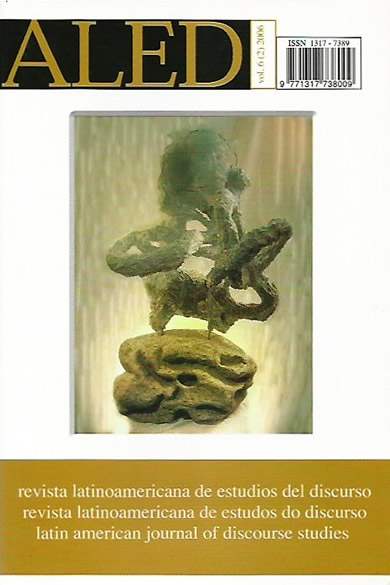Estado argentino y cumbia villera
Keywords:
cumbia villera. sociology of language. representation. attitude. linguisticpolicy. linguistic planning.Abstract
This study aims to analyze Pautas de evaluación para los contenidos de la cumbia villera (COMFER, 2001) from the perspective of the Sociology of Language (Calvet, 1997; Cooper, 1997) to identify the attitude (Baker, 1992) and the sociolinguistic representations (Boyer, 1991) of the state with respect to this genre. Based on the assumption that the tools of analysis, which allow the intervention of state policy and language planning reveal the power relationships that are played within a particular society at a given moment (Calvet , 1997), it will be shown that the Pautas are intended to intervene the language in order to regulate its use and its form and defend what they recognize as ‘legitimate language’.
Downloads
References
ALVARADO, M. (1994) Paratexto. Buenos Aires: Eudeba Colección EnciclopediaSemiológica.
AMOSSY & HERSCHBERG PIERROT. (2001) Estereotipos y clichés. BuenosAires: Eudeba.
BAKER, C. (1992) Attitudes and language. Clevedon: Multilingual Matters.
BOYER, H. (1991) Langues en conflit. Paris: L’Harmattan.
CALVET, L. J. (1997) Las políticas lingüísticas. Buenos Aires: EDICIAL
COOPER, R. L. (1997) La planificación lingüística y el cambio social. Madrid:Cambridge University Press.
COMFER. (2001) Pautas de evaluación para los contenidos de la cumbia villera.Documento oficial del gobierno argentino disponible en: http://www.comfer.gov.ar/documentos/pdf/villera.pdf.
NINYOLES, R. L. (1972) Idioma y poder social. Madrid: Tecnos.
REGUILLO CRUZ, R. (2000) ‘Pensar los jóvenes. Un debate necesario’, enEmergencia de culturas juveniles. Estrategias del desencanto. Buenos Aires: Norma.
STEWART, W. A. (1968) ‘A sociolinguistic typology for describing nationalmultilingualism’, en J. Fishman (ed.) Readings in the Sociology of Language.Mouton: La Haya.
VÁZQUEZ VILLANUEVA, G. y VITALE, M. A. (2000) ‘Las leyes argentinassobre radiodifusión: políticas culturales y unificación lingüística’, en http://biblio.fcedu.uner.edu.ar/v_jornadas/ponencias/Area02/Vazquez_Vitale.html
WEINREICH, U. (1973) ‘Unilinguisme et multilinguisme’, en Enciclopédie dela Pleïade, Gallimard. S./d.
Downloads
Published
How to Cite
Issue
Section
License

This work is licensed under a Creative Commons Attribution-NonCommercial-NoDerivatives 4.0 International License.
The authors retain the copyright and guarantee RALED the right to be the first publication of the work as well as a Creative Commons Attribution License that allows others to share the work with recognition of authorship and the initial publication in this journal.




